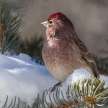
The White-bellied Nothura is a small tinamou typical of arid and semi-arid scrub in the northern Chaco region of central southern South America, in eastern Bolivia, Paraguay and southwest Brazil. Like other nothuras and unlike many other tinamous species in other genera, this species is seen more often than not, inhabiting a relatively open climate. The White-bellied Nothura, however, can be wary and elusive, and is known to take shelter in burrows created by other animals, including armadillos. The White-bellied Nothura can often be seen along secondary roads and in holes as it forages by pecking off the ground seeds, roots, and fruits; and is distinctive when properly viewed, with an unpatterned whitish wash to the underpieces and soft mustard-yellow paws. The Nothuras are an initially puzzling array of open-country low, dispersed, brownish. Both are nearly similar but because of the limited ranges of other species they can usually be identified relatively easily. The White-bellied Nothura is limited to the Chaco, and is the most prevalent in the lagoon district of Central Chaco, where it is frequently seen on roads and in farmland. It might sound relatively unwritten, but it is the possession of a pair of bright yellow diagnostic legs! Its scientific name boraquira derives from a traditional Brazilian term that means "hole tinamou" in reference to its habit of taking shelter while found in armadillo holes. The nothura white-bellied (Nothura boraquira) is a genus of tinamou found in dry shrublands in northeastern Bolivia, western Paraguay and northeastern Brazil. Bellied in brown, the nothura is a monotypical genus. Both tinamous are of the tribe of Tinamidae, and are thus ratites in the broader scheme. Unlike other ratites, tinamous can float but in general they are not good fliers. Both ratites evolved from ancient flying birds, and tinamous are the closest surviving descendants of such species. The white-bellied nothura is some 27 cm long. Its uppermost sections are light brown with white streaks and black bars. She has a white chest, her foreneck is full of black streaks, her breast is brown and her belly is flat. The crown is dark brown, and the sides of its head are grey. The legs are bright yellow, and the inner webs of their primaries are uniformly black, unlike the closely related spotted nothura. The nothura white-bellied consumes fruit from the ground or low-lying trees as opposed to other tinamous ones. Tiny numbers of invertebrates, blooms, delicate leaves, seeds, and roots are also eaten. The male incubates the eggs which can come from as many as four different females, and then holds them up until they can be autonomous, normally 2–3 weeks. On the field the nest is in dense scrub, in between high root buttresses. The white-bellied nothura prefers dry shrubland regions to 500 m above sea level. Also in tropical grasslands, savanna, caatinga and sometimes pastures this can be seen. This plant is native to Brazil's central and northeastern areas, east Bolivia and Paraguay. The IUCN classifies this species as Least Concern, with an occurrence size of 1.400.000 km2. The White-Bellied Nothura is a type of Tinamous that is commonly found in dry shrublands in northern Chaco region of central-southern South America. It is native to eastern Bolivia, Paraguay, apart from northeastern and central Brazil. The White-Bellied Nothura is a relatively small genus, with black-barred, light-brown tops and green streaked. It has ivory collar and throat, a buff breast and a dark-brown crown. The White-Bellied Nothura is readily differentiated from other Nothuras because of its unique pattern and bright-yellow legs. As with other tinamou species, the White-Bellied Nothura nest is located in dense brush on the ground or under elevated root buttresses. The male incubates the eggs that emerge from as many as four individual females. Then, he gathers up the chicks until they can be alone, usually for 2-3 weeks.
About the Creator
MB
I am a bird aficionado and really enjoy spotting them them on hikes. I greatly appreciate the variety of birds cross North America and the world. They are amazing and intelligent creatures, each so unique and with a wonderful life.






Comments
There are no comments for this story
Be the first to respond and start the conversation.